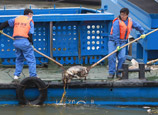
Given the difficulty and expense of separating plastics, the most economically viable option is often secondary recycling of a few commodity thermoplastics - mostly bottles, for which collection infrastructure is already in place.
More economical separation methods are crucial to expanding the scope of plastics recycling, as is the identification of new potential markets for the recyclates.
Such developments would encourage industry to re-use or recycle more parts. Although all 40 kinds of plastics used in a North American automobile can be recycled, the need to separate and clean them makes using them more expensive than using virgin plastic resins.
This translates into a higher proportion of plastics in the remnants of shredded end-of-life automobiles -a contaminated mixture of plastics and non-plastics that is usually disposed of through some combination of land-filling, incineration, and secondary recycling.
Increasing the proportion of re-used plastics is a crucial step toward more sustainable plastics consumption.
To this end, some automobile manufacturers have adjusted their designs to allow for easy disassembly of parts made of compatible plastics, while governments have set recycling target proportions for end-of-life vehicles. Such efforts should be intensified.
Down-gauge
Furthermore, industry should seek new applications for recycled materials, while minimizing the amount of virgin material used. And, where possible, manufacturers should "down-gauge" materials (make parts thinner).
Government legislation can be enacted to support such measures, as well as to require plastics manufacturers to get involved in the disposal of plastic items - a responsibility long imposed on packaged-goods manufacturers in Europe.
An example of successful waste management is the reprocessing of PET bottles (made of polyethylene terephthalate) into polyester fibers.
In the last decade, Japan passed several laws obliging both businesses and individuals to separate plastics waste. This, combined with a lack of landfill space and the country's expanding population, has enhanced plastics recycling efforts.
As a result, in 2010, Japan recycled 72 percent of PET bottles, compared to roughly 30 percent in the US and 48 percent in Europe. While incineration and land-filling are still practiced, such high recycling rates underscore the positive impact of targeted policies.
Another promising development is bioplastics, which have begun to compete with petroleum-based products in certain short-lifespan applications - such as packaging and agriculture - over the last two decades.
Given that bioplastics are produced from renewable or "bio-based" sources (cellulose, starch, and glucose) - and, in some cases, through microbial fermentation - they have a lower carbon footprint, contribute less to global warming, and biodegrade to small molecules.
But bioplastics are not a silver bullet for managing plastics waste.
In fact, they may threaten the secondary recycling of petroleum-based plastics, owing to possible contamination during sorting of mixed streams.
And critics have expressed concern about the environmental impact of corn and other crops grown for industrial purposes, such as plastics and ethanol production, not to mention the potential effects on global food prices.
In a world that is reliant on plastics, more sustainable production, consumption, and disposal of plastic products is crucial. Civil society, industry, and government must work together to increase the share of recycled plastics, thereby ensuring that plastics' costs do not outweigh their benefits.
Marino Xanthos is professor of chemical, biological, and pharmaceutical engineering at the New Jersey Institute of Technology. Copyright: Project Syndicate, 2013.www.project-syndicate.org

















 What house can you buy with 1 million yuan in China?
What house can you buy with 1 million yuan in China?


![]()
